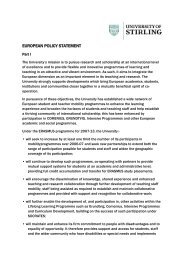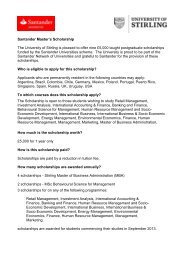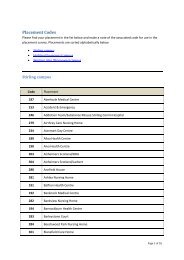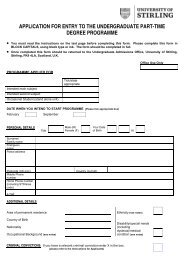Health First: An evidence-based alcohol strategy for the UK
Health First: An evidence-based alcohol strategy for the UK
Health First: An evidence-based alcohol strategy for the UK
Create successful ePaper yourself
Turn your PDF publications into a flip-book with our unique Google optimized e-Paper software.
<strong>Health</strong> <strong>First</strong>: an <strong>evidence</strong>-<strong>based</strong> <strong>alcohol</strong> <strong>strategy</strong> <strong>for</strong> <strong>the</strong> <strong>UK</strong><br />
Drink driving: <strong>the</strong> legal blood<br />
<strong>alcohol</strong> limit<br />
Drink driving remains a major cause of injury and<br />
death in <strong>the</strong> <strong>UK</strong>. In 2011, drink driving resulted<br />
in 9,990 casualties including 280 deaths on British<br />
roads 1 . <strong>An</strong>alysis of road traffic deaths reveals <strong>the</strong><br />
extent to which <strong>alcohol</strong> is implicated: over half (54%)<br />
of <strong>the</strong> cases examined by coroners involve drugs and/<br />
or <strong>alcohol</strong> with 42% involving <strong>alcohol</strong> only 2 . In England,<br />
<strong>the</strong> cost of drink driving is estimated to be £500million<br />
per year 3 .<br />
These harms are best tackled through population<br />
to between 20 and 50mg/100ml reduces this risk to<br />
around three times that of <strong>the</strong> completely sober driver.<br />
Crucially, <strong>the</strong>re is convincing <strong>evidence</strong> that lowering<br />
<strong>the</strong> legal blood <strong>alcohol</strong> limit would affect <strong>the</strong> behaviour<br />
of drivers at all blood <strong>alcohol</strong> levels, including those<br />
drivers who drink heavily and in excess of <strong>the</strong> current<br />
80mg/100 ml limit 8 .<br />
The impact of any change in <strong>the</strong> limit will be constrained<br />
by <strong>the</strong> ef<strong>for</strong>t put into its en<strong>for</strong>cement. In fact, improving<br />
en<strong>for</strong>cement would itself have a dramatic impact<br />
on drink driving harms. In Australia, <strong>for</strong> example,<br />
<strong>the</strong> introduction of random breath-testing reduced<br />
<strong>alcohol</strong>-related fatalities by 33% and injuries by 17% 9 .<br />
The NICE guidelines recommend <strong>the</strong> introduction<br />
Lowering <strong>the</strong> legal blood <strong>alcohol</strong> limit would affect<br />
<strong>the</strong> behaviour of drivers at all blood <strong>alcohol</strong> levels,<br />
including those drivers who drink heavily<br />
measures to reduce <strong>alcohol</strong> consumption, i.e. <strong>the</strong><br />
measures described in chapters 3 to 6 to make<br />
<strong>alcohol</strong> less af<strong>for</strong>dable, less attractive, less visible<br />
and less available. However, targeted driver-specific<br />
interventions are also needed to reduce <strong>the</strong> incidence<br />
of <strong>alcohol</strong>-related road accidents.<br />
The legal blood <strong>alcohol</strong> concentration limit <strong>for</strong> drink<br />
driving is currently set at 80mg/100ml in <strong>the</strong> <strong>UK</strong>, <strong>the</strong><br />
highest – and thus least stringent – limit in Europe with<br />
<strong>the</strong> exception of Malta. Although <strong>the</strong> introduction<br />
of this limit in 1967 reduced <strong>the</strong> number of <strong>alcohol</strong>related<br />
deaths on <strong>the</strong> roads 4 , <strong>the</strong>re is clearly scope to<br />
go fur<strong>the</strong>r. A review <strong>for</strong> NICE indicated that lowering<br />
<strong>the</strong> limit to 50mg/100ml would reduce fatalities by<br />
6.4% and injuries by 1.4% in <strong>the</strong> first year after its<br />
implementation 5 . The Scottish government has recently<br />
indicated that it intends to lower <strong>the</strong> blood <strong>alcohol</strong><br />
concentration limit <strong>for</strong> drink driving to 50g/100ml and<br />
<strong>the</strong> Nor<strong>the</strong>rn Ireland government is consulting on a<br />
similar reduction.<br />
NICE’s recommendation 6 to reduce <strong>the</strong> blood <strong>alcohol</strong><br />
concentration limit to 50mg/100ml is supported by <strong>the</strong><br />
North Review of <strong>the</strong> Drink and Drug Driving Law 7 which<br />
noted that, although any <strong>alcohol</strong> consumption impairs<br />
driving, a driver with a blood <strong>alcohol</strong> concentration of<br />
between 50 and 80mg/100ml has at least six times <strong>the</strong><br />
risk of dying in a crash than a driver who has drunk<br />
no <strong>alcohol</strong>. Reducing <strong>the</strong> blood <strong>alcohol</strong> concentration<br />
of both random breath-testing and selective testing<br />
at ‘sobriety checkpoints’. Such measures have a<br />
potentially powerful deterrent effect.<br />
Such changes in policy must be communicated to <strong>the</strong><br />
public through mass media campaigns which both<br />
reiterate <strong>the</strong> dangers of drink driving and make drivers<br />
aware of <strong>the</strong> changes to <strong>the</strong> legal blood <strong>alcohol</strong> limit.<br />
Recommendations<br />
The legal limit <strong>for</strong> blood <strong>alcohol</strong><br />
concentration <strong>for</strong> drivers should be<br />
reduced to 50mg/100ml.<br />
Random breath-testing of drivers should<br />
be introduced.<br />
Drink driving: graduated driver<br />
licensing<br />
Younger drivers are particularly at risk of crashing<br />
when <strong>the</strong>y have been drinking because <strong>the</strong>y are less<br />
experienced drivers, less mature and have a lower<br />
tolerance of <strong>the</strong> effects of <strong>alcohol</strong> than older people.<br />
Younger drivers may also be predisposed to risk-taking.<br />
Drivers between <strong>the</strong> ages of 17 and 24 are far more<br />
37
















